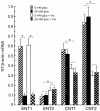Reduced ability to release adenosine by diabetic rat cardiac fibroblasts due to altered expression of nucleoside transporters
- PMID: 16873415
- PMCID: PMC1995644
- DOI: 10.1113/jphysiol.2006.111278
Reduced ability to release adenosine by diabetic rat cardiac fibroblasts due to altered expression of nucleoside transporters
Abstract
Adenosine produced by cardiac cells is known to attenuate the proliferation of cardiac fibroblasts (CFs), inhibit collagen synthesis, and protect the myocardium against ischaemic and reperfusion injury. Diabetic patients' hearts exhibit ventricular hypertrophy and demonstrate reduced tolerance to hypoxia or ischaemia. In this study, we characterize the effects of glucose and insulin on processes that determine the release of adenosine from CFs. We showed that during ATP depletion, rat CFs cultured in the absence of insulin release significantly less adenosine compared to cells grown in the presence of insulin. Moreover, under both conditions the quantity of released adenosine depends on glucose concentration. We demonstrate that this is due to altered expression of nucleoside transporters. High glucose (25 mm) induced 85% decrease in nucleoside transporter ENT1 mRNA levels. Decrease of the insulin level below 10(-11) m resulted in over 3-fold increase in the nucleoside transporter CNT2 mRNA content. Measurements of adenosine transport in CFs cultured in the presence of 5 mm glucose and 10 nm insulin showed that the bidirectional equilibrative adenosine transport accounted for 70% of the overall adenosine uptake. However, cells grown in the presence of high glucose (25 mm) demonstrated 65% decrease of the bidirectional equilibrative adenosine transport. Experiments on CFs cultured in the absence of insulin showed that the unidirectional Na(+)-dependent adenosine uptake rose in these cells more than 4-fold. These results indicate that the development of diabetes may result in an increased uptake of interstitial adenosine by CFs, and reduction of the ability of these cells to release adenosine during ATP deprivation.
Figures






References
-
- Bell DSH. Heart failure: the frequent, forgotten, and often fatal complication of diabetes. Diabetes Care. 2003;26:2433–2441. - PubMed
-
- Burgdorf C, Richardt D, Kurz T, Seyfarth M, Jain D, Katus HA, Richardt G. Adenosine inhibits norepinephrine release in the postischemic rat heart: the mechanism of neuronal stunning. Cardiovasc Res. 2001;49:713–720. - PubMed
-
- Camelliti P, Borg TK, Kohl P. Structural and functional characterisation of cardiac fibroblasts. Cardiovasc Res. 2005;65:40–51. - PubMed
-
- Chen Y, Epperson S, Makhsudova L, Ito B, Suarez J, Dillmann W, Villarreal F. Functional effects of enhancing or silencing adenosine A2b receptors in cardiac fibroblasts. Am J Physiol Heart Circ Physiol. 2004;287:H2478–H2486. - PubMed
-
- Deussen A. Metabolic flux rates of adenosine in the heart. Naunyn Schmiedebergs Arch Pharmacol. 2000;362:351–363. - PubMed
Publication types
MeSH terms
Substances
LinkOut - more resources
Full Text Sources

